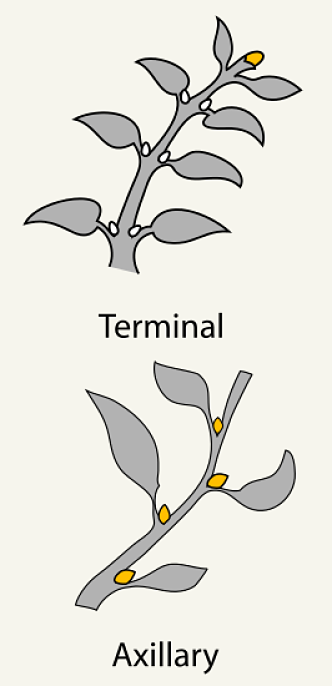This post may contain affiliate links. As an Amazon Associate we earn from qualifying purchases.
Apical dominance: Why should you care? If you prune your plants, you should care … a lot!
If you look closely at a typical shoot on a bush you will see the tip of it holds a bud. This is known as the apical or terminal bud and it dominates the rest of the buds on the shoot.

Think of it as the boss of all the others, telling them when they can and cannot grow.
Scientists believe that apical buds release a hormone, or auxin, that causes the lateral, or axillary buds – those along the side — to remain dormant.
When you remove the terminal bud, you remove its dominance and the lower buds are then free to grow. This is why you’ll see instructions for some plants, such as sunflowers and peas, that suggest you should “pinch off the tips,” or “head back.”

Keep in mind that when you prune down to a lateral branch (a branch that branches off from the main stem) a new terminal bud will be created.
How you prune bushes with intense apical dominance depends upon what you want from the bush: taller or wider growth. Keep in mind that apical dominance is temporary. Some bushes suppress growth until the following season, others allow it during the same season, but later.
Let’s walk through the basics
Determine the best time to prune the bush. Spring flowering bushes are generally pruned after they flower while summer flowering bushes are best pruned during the dormant season.
This is such a broad generalization so consult with your county cooperative extension office if you have any doubts about when to prune the shrub. Find your cooperative extension office here.
Encourage the bush to produce lateral growth by cutting shoots 1/2 inch above a bud that is pointing in the direction in which you want the bush to grow.
For instance, because rose bushes require good interior air circulation, rosarians prune shoots to an outward-facing bud. This encourages the new shoot to grow out, and not toward the middle of the plant.
Suppress lateral growth when pruning by allowing some apical buds to remain on the bush. This encourages the plant to grow taller.
Because the wood you are removing contains the plant’s carbohydrate reserves, never remove more than one-third of the plant.
If you must severely prune, be aware that the shrub will take some time to recover and that it’s more susceptible to pests and diseases during recovery.
Learn more about apical dominance and pruning woody plants at the University of Georgia Cooperative Extension Service’s website.



